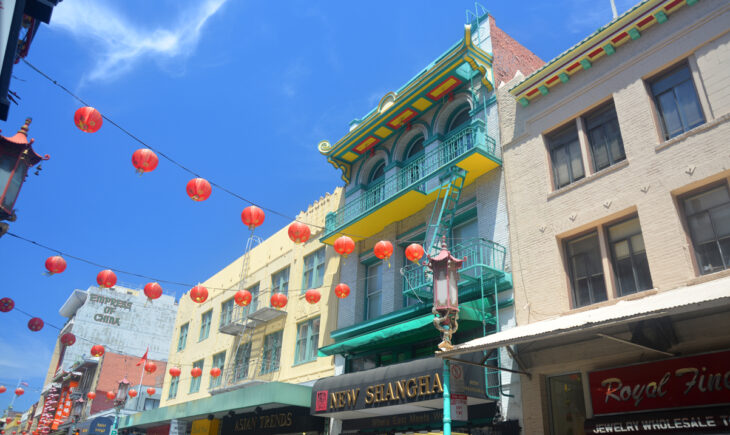The California Gold Rush of 1849 brought thousands of people to the state, often from very distant locations. Some made their way across the great plains and over the mountains. Others arrived by boat, even originating from other countries, but none more so than from China. Thousands of Chinese working class immigrants arrived in the early 1850’s, and almost all came through the Port of San Francisco. While some were able to become successful independent prospectors, others became employed by various mining companies throughout the Old West, but most found jobs working with growing companies in need of large labor pools, especially the Central Pacific during their building of the Transcontinental Railroad. The availability of railroad jobs brought yet more Chinese immigrants through the Port of San Francisco. With such a large influx of Chinese people, it wasn’t long before an entire section of the city began to be dominated by Chinese culture. Shops and restaurants catering to the people were built on the ground floors, while the few floors above were devoted mainly to tenements. Interestingly, the same Transcontinental Railroad that many Chinese immigrants had worked on brought large amounts of settlers and visitors across the country, and the tourist industry of San Francisco and especially Chinatown itself was born. So the popularity of Chinatown has existed for over 150 years! Most visitors to Chinatown were interested in experiencing the exotic and mysterious culture from far across the Pacific Ocean. As such, Chinatown became a hotspot for where West meets the East. And it has only grown in popularity since then. Today, Chinatown is the largest tourist destination in San Francisco, beating even that of the Golden Gate Bridge. While the massive earthquake of 1906 destroyed all of Chinatown, which at the time was mainly dilapidated buildings, it allowed city planners and architects to reconstruct a cleaner Chinatown with a much more Asian inspired architecture and decor. The above image shows a typical example of this, taken along the heart of Grant Avenue. Captured by The Wild Images Team during one of our treks through Chinatown, it highlights many aspects of Asian culture and architecture. This includes the colorful designs of the New Shanghai building, the iconic dragon streetlamps, and a view of the famous Empress of China banquet hall through the lanterns strung across the street. The Wild Images Team has captured many other photos from California such as the scene of a blooming thunderstorm over Joshua Tree National Park, the lava flow created streaked ridge in Lassen Volcanic National Park, and the high altitudes where a giant sequoia is larger and redder than others, the steep Hyde Street view of Alcatraz Island and San Francisco Bay, the drastic slope of the abrupt drop off of Taylor Street, the Pine Street colorful terraced houses with background buildings, the historic looking beautiful terraced houses and a Classic VW Beetle, and the Asian inspired intricately ornate Chinatown scene, each of which are available for sale in our store. Blog posts from California have documented the long and winding road climb to the giants of Sequoia National Park, the size comparison of The Wild Images Team Coordinator Christina and the giant tree, the massive view where giant sequoias maintain their diameters over hundreds of feet, an overlook into the Merced River Valley with Liberty Cap, the road heading towards the sheer monolith of El Capitan, the road heading towards desolate ridges of Joshua Tree National Park, the location where the road rises out of Bumpass Hell, a beach dune covered view of the secret underground World War II bunker, the reflective tower of the Marriott Marquis over the Yerba Buena Gardens, the distinctively ornate Asian architecture and decor of Chinatown, the musically inspired melting records with album covers mural, the long strange trip of the Grateful Dead Jerry Garcia mural, the places where steep sidewalks have stairs cut into them, the street where a tree gives a sense of the steepness, the expansive view of Nob Hill from Telegraph Hill and the oppositely directed view from Telegraph Hill to the northeast, the descent in the upper portion of the Filbert Steps, followed by the middle portion of the Filbert Steps with a pose by The Wild Images Team Coordinator on the steps, followed by the lower portion of the Filbert Steps, and at the bottom a view up the Filbert Street steps again with a pose by The Wild Images Team Coordinator below the steps. From our travels in the nearby Oregon and Washington, we have captured photos such as the deep blue hues of swirled clouds and rim peaks reflected in Crater Lake, the Hoh Rainforest green moss covers every possible branch, and the right place at the right time rainbow over the Mt. St. Helens remnants, each of which are available for sale in our store. Blog posts from Oregon and Washington include the sharp looking view through the Lava Cast Forest, the optical illusion of blue waters and white streaks in Crater Lake, the starkly colorful rainbow rises over the devastation of Mt. St. Helens, the moment The Wild Images Team Coordinator Christina is imprisoned by rainforest tree roots, the interesting story of the Port Angeles waterfront Rocktopus Sculpture, and its accompanying bronze plaque of charitable organizations.
To see more photos, please visit our store



1 thought on “The Beautiful Asian Inspired Architecture And Decor Found Within The Chinatown Portion Of San Francisco”
Comments are closed.